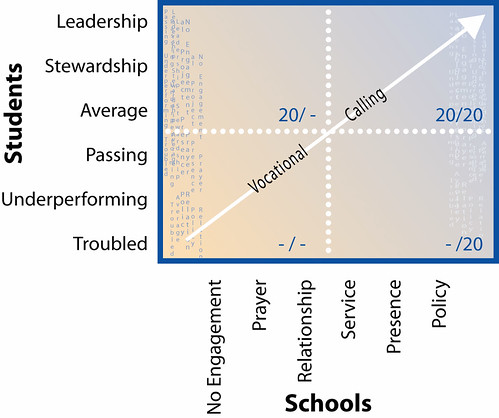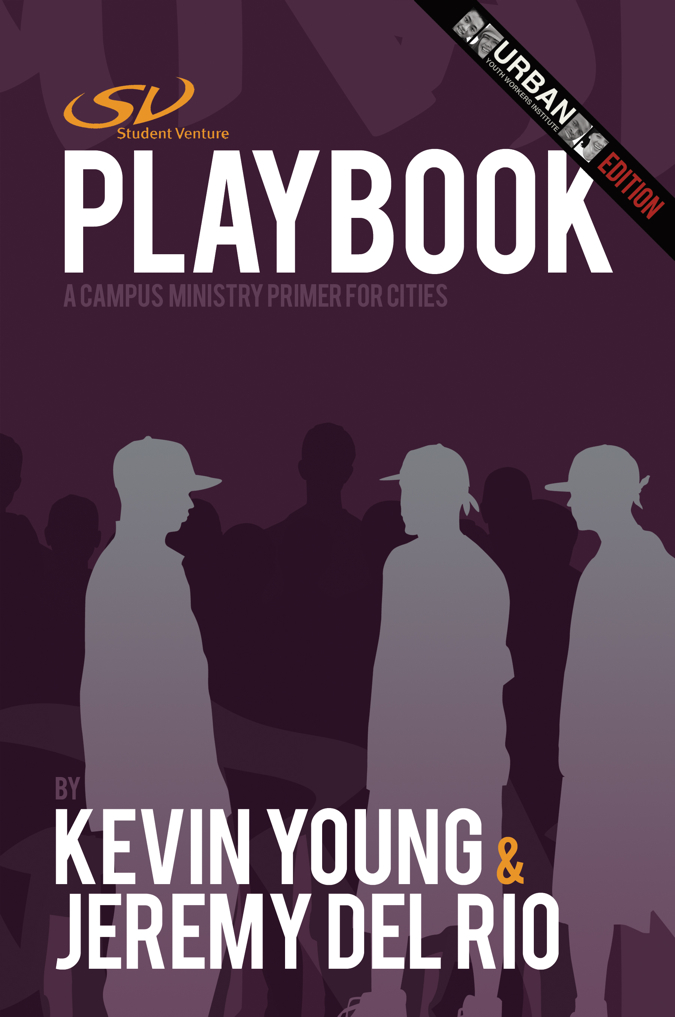20/20 Vision for Schools: Transforming Public Education within a Single Generation of Students
[Ed Note: This article originally appeared in the January 2008 issue of Tri-State Voice
and was syndicated nationally.]
Youth Pastor Edwin Pacheco is on a mission to save New York City’s public schools.
But unlike some of who prefer a fire and brimstone approach, Pacheco’s primary concern isn’t escape from hell. It’s God’s kingdom “on earth as it is in heaven,†and it responds in real time to the felt-needs of real youth in his community.
Corrective Lenses

As point person for the newly announced
20/20 Vision for Schools, an adopt-a-school initiative spearheaded by the inter-denominational
Coalition of Urban Youth Workers, Pastor Edwin asks: “What kind of impact can New York City’s 7,100 evangelical and Pentecostal churches have on its 1,400 public schools, if we adopt those schools for meaningful prayer, advocacy, and service?â€
He strikes an urgent chord in noting that incoming first graders in September 2008 will be the graduating high school class of 2020. “Dare we expect God to answer our prayers within a single generation of students?â€
It’s a vital question as Pacheco ministers to teens that struggle with reading and math. Even after six years of Mayor Bloomberg’s education reform, nearly 60% of public school students still cannot read at grade level and nearly 70% still cannot perform basic math. In a system comprised of 1.2 million students (the 10th largest American city), populations larger than Seattle and Boston and Washington, DC, under-perform in our schools everyday.
Pacheco describes the implications of such staggering failure: “If a child cannot read, he cannot complete a job application or engage an information economy (or study scripture). If she cannot do math, she cannot balance a checkbook or determine why last month’s fashions don’t have to be replaced (or calculate tithes). Our students are ill equipped to become who God created them to be.â€
Jose Dobles of Youth Ministries for Peace and Justice puts it this way: “Churches are not only responsible for the spiritual well being of the individual but also for the redemption of the larger society. As disciples of Jesus we must follow his call to action and realize that personal salvation must lead to an action beyond oneself.†Doing so is, “one way in which the faith community can follow the Biblical mandate to do justice and walk humbly with our God.â€
A plentiful harvest, but where are the laborers?
With schools squarely in his sights, Pacheco has redefined youth ministry beyond the old paradigms of youth group altar calls and pizza parties both in his home church of Bay Ridge Christian Center and among the bi-vocational youth pastors he networks through Youth Rock. “Youth ministry is not about ministering to youth. It’s about empowering them to minister.â€
Pacheco attributes his paradigm shift in part to a breakfast the Coalition hosted in 2005 for the NY Billy Graham Crusade. One of the presenters asked how many of the 787 youth workers in attendance get paid to do youth ministry. For Pastor Edwin and Coalition co-founder Kevin Young, the three-dozen mostly para-church hands that went up vividly captured both the state of youth ministry in the city and the picture Jesus painted of a plentiful harvest and too few laborers. Relying on several dozen vocational ministers to reach 2 million youth in the five boroughs and 5 million in metropolitan New York would remain an exercise in futility.
As area director of Student Venture, the high school ministry of Campus Crusade, Young was one of the few “professionals†at the breakfast and has been one of the architects of 20/20. If an outmanned and under-resourced labor force can stand a chance, he reasoned, then reinforcements would have to come from within our congregations. He began calling for churches “to redefine ‘youth minister’ to include any believer who maintains any meaningful contact with youth, such as: parents, mentors, teachers, custodians, health care workers, entrepreneurs who hire teens or market sneakers at them, and especially other students.â€
Peter Ong, director of the Laity Project for PaLM (Pastoral and Laity Ministries), agrees with Kevin’s assessment. “For Jesus, laborers were not limited to the twelve disciples. Those who actually do ‘the work of ministry’ are the people in the pews, not those behind the pulpit.â€Â Ong, who has ministered to Chinatown teens for more than a decade, notes that this expansive view is especially critical within immigrant congregations.
The Adoption Matrix
Mobilizing congregations for prayer and scalable engagement requires a plan, and for two years, Coalition members experimented with grassroots models for how to adopt local schools. What has emerged Pacheco describes as a matrix designed to move congregations through seven levels from no engagement to holistic, 20/20 engagement.

Adoption begins by identifying a specific neighborhood school for intentional and consistent prayer. It continues as congregations overcome generational mistrust by cultivating personal relationships at the school, what Pastor Ray Parrascondo of Staten Island calls building a “resume of trust.â€
Beyond relationships are meaningful acts of service, where congregations become answers to prayer and offer tangible value to the school. Next is a ministry of presence, where churches meet ongoing needs by volunteering as coaches, lunchroom monitors, or tutors; sponsoring extra-curricular activities; or coordinating after school leadership clubs. Finally comes the credibility to speak into policy decisions both at the school and systemic level. A church holistically engaged in this way is a 20/20 church.
Visionary Leadership
Coalition strategist Nicole Baker cautions that youth pastors alone cannot implement 20/20 Vision. Congregational support requires the commitment of senior pastors and church elders as well. Rev. Gary Frost, director of leadership collaboration for the NYC Leadership Center and senior pastor of Evergreen Baptist Church in Brooklyn, is even more bold: “Adopting schools is an idea whose time has come. 20/20 Vision is a workable strategy for scalable impact that moves congregations beyond ‘evangelical’ to evangelistic.â€
Rev. Frost should know. In his previous role as executive director of the Metropolitan New York Baptist Association, he was the first denominational leader to invest monetary resources to help churches adopt schools this summer.
For three years, MNYBA had sponsored a short-term missions experience for the Southern Baptist Convention called Paint the Town, which mobilized over 3,000 volunteers from around the country to beautify New York City schools. In 2007, after hearing the 20/20 Vision concept, Rev. Frost recognized PTT as a unique opportunity to empower local congregations to establish or enhance existing relationships with local schools.
Rather than rely on centralized PTT staff to identify and manage the projects as MNYBA had done in prior years, Rev. Frost offered grants totaling $100,000 to congregations to work directly with neighborhood schools.
Rev. Frost aligned PTT with 20/20 and invited the Coalition to help identify local ministries for grants. His theory: “If a church was already praying for a school, then PTT would represent an answer to those prayers. What better way to engage schools generally than to become a resource for congregations that had already embraced specific schools?â€
Perhaps most radical of all, Rev. Frost designated up to 30% of the grants for non-Baptist ministries in order to invest in the Coalition’s recommendations without regard to denominational affiliation.
The result was eleven PTT projects in all five boroughs and New Jersey. Some strengthened ongoing relationships between established churches and community schools. Others forged new relationships for church plants. Still others provided opportunities for congregations to rediscover God’s passion for their neighborhoods.
All, however, reported opened hearts and minds that produced what Walter Sotelo of CitiVision called “crazy glue†connections between schools and their sponsoring churches. Jannie Wolff of Abounding Grace described how the influx of volunteers prompted onlookers to ask who they were and why they kept coming. As word spread, individuals approached them looking for prayer. Pastor Ed Perry of Bethsalem Church described how PTT helped restore confidence in the faith community. For the principal he described a conversion of sorts, moving from cynic to a believer in the church’s ability to deliver on its promises.
Milestones
While the Coalition rhetorically challenges all 7,100 NYC churches to adopt a school, its short-term objectives are much more manageable. Baker, director of the Queens Boro Pregnancy Counseling Center, notes that, “If just 10% of the 7,100 churches (710) made commitments to pray for one school each – a tithe of all the churches in the city – then half the schools (700) would be covered.â€Â With 10% as its three-year goal, the Coalition hopes to recruit 71 churches, or 1%, to officially launch 20/20 Vision in September.
To that end, the Coalition is planning informational workshops throughout the spring, and exploring funding possibilities for service projects this summer. Also in the works: a forum with school officials, teachers, and clergy; and a Back-to-School Commissioning Sunday in September with all 20/20 churches. Visit www.CoalitionNYC.com/adopt-a-school for prayer guides, sermon notes, and to register your church’s involvement.
- Jeremy Del Rio, Esq. advises churches and non-profits on youth culture and community development. Visit him online at www.JeremyDelRio.com
Related
+ "
Case Study: How One Church Adopted a Neighborhood Public School" (The case study accompanied the article as a Sidebar in
Tri-State Voice)
 As point person for the newly announced 20/20 Vision for Schools, an adopt-a-school initiative spearheaded by the inter-denominational Coalition of Urban Youth Workers, Pastor Edwin asks: “What kind of impact can New York City’s 7,100 evangelical and Pentecostal churches have on its 1,400 public schools, if we adopt those schools for meaningful prayer, advocacy, and service?â€
He strikes an urgent chord in noting that incoming first graders in September 2008 will be the graduating high school class of 2020. “Dare we expect God to answer our prayers within a single generation of students?â€
It’s a vital question as Pacheco ministers to teens that struggle with reading and math. Even after six years of Mayor Bloomberg’s education reform, nearly 60% of public school students still cannot read at grade level and nearly 70% still cannot perform basic math. In a system comprised of 1.2 million students (the 10th largest American city), populations larger than Seattle and Boston and Washington, DC, under-perform in our schools everyday.
Pacheco describes the implications of such staggering failure: “If a child cannot read, he cannot complete a job application or engage an information economy (or study scripture). If she cannot do math, she cannot balance a checkbook or determine why last month’s fashions don’t have to be replaced (or calculate tithes). Our students are ill equipped to become who God created them to be.â€
Jose Dobles of Youth Ministries for Peace and Justice puts it this way: “Churches are not only responsible for the spiritual well being of the individual but also for the redemption of the larger society. As disciples of Jesus we must follow his call to action and realize that personal salvation must lead to an action beyond oneself.†Doing so is, “one way in which the faith community can follow the Biblical mandate to do justice and walk humbly with our God.â€
A plentiful harvest, but where are the laborers?
With schools squarely in his sights, Pacheco has redefined youth ministry beyond the old paradigms of youth group altar calls and pizza parties both in his home church of Bay Ridge Christian Center and among the bi-vocational youth pastors he networks through Youth Rock. “Youth ministry is not about ministering to youth. It’s about empowering them to minister.â€
Pacheco attributes his paradigm shift in part to a breakfast the Coalition hosted in 2005 for the NY Billy Graham Crusade. One of the presenters asked how many of the 787 youth workers in attendance get paid to do youth ministry. For Pastor Edwin and Coalition co-founder Kevin Young, the three-dozen mostly para-church hands that went up vividly captured both the state of youth ministry in the city and the picture Jesus painted of a plentiful harvest and too few laborers. Relying on several dozen vocational ministers to reach 2 million youth in the five boroughs and 5 million in metropolitan New York would remain an exercise in futility.
As area director of Student Venture, the high school ministry of Campus Crusade, Young was one of the few “professionals†at the breakfast and has been one of the architects of 20/20. If an outmanned and under-resourced labor force can stand a chance, he reasoned, then reinforcements would have to come from within our congregations. He began calling for churches “to redefine ‘youth minister’ to include any believer who maintains any meaningful contact with youth, such as: parents, mentors, teachers, custodians, health care workers, entrepreneurs who hire teens or market sneakers at them, and especially other students.â€
Peter Ong, director of the Laity Project for PaLM (Pastoral and Laity Ministries), agrees with Kevin’s assessment. “For Jesus, laborers were not limited to the twelve disciples. Those who actually do ‘the work of ministry’ are the people in the pews, not those behind the pulpit.â€Â Ong, who has ministered to Chinatown teens for more than a decade, notes that this expansive view is especially critical within immigrant congregations.
The Adoption Matrix
Mobilizing congregations for prayer and scalable engagement requires a plan, and for two years, Coalition members experimented with grassroots models for how to adopt local schools. What has emerged Pacheco describes as a matrix designed to move congregations through seven levels from no engagement to holistic, 20/20 engagement.
As point person for the newly announced 20/20 Vision for Schools, an adopt-a-school initiative spearheaded by the inter-denominational Coalition of Urban Youth Workers, Pastor Edwin asks: “What kind of impact can New York City’s 7,100 evangelical and Pentecostal churches have on its 1,400 public schools, if we adopt those schools for meaningful prayer, advocacy, and service?â€
He strikes an urgent chord in noting that incoming first graders in September 2008 will be the graduating high school class of 2020. “Dare we expect God to answer our prayers within a single generation of students?â€
It’s a vital question as Pacheco ministers to teens that struggle with reading and math. Even after six years of Mayor Bloomberg’s education reform, nearly 60% of public school students still cannot read at grade level and nearly 70% still cannot perform basic math. In a system comprised of 1.2 million students (the 10th largest American city), populations larger than Seattle and Boston and Washington, DC, under-perform in our schools everyday.
Pacheco describes the implications of such staggering failure: “If a child cannot read, he cannot complete a job application or engage an information economy (or study scripture). If she cannot do math, she cannot balance a checkbook or determine why last month’s fashions don’t have to be replaced (or calculate tithes). Our students are ill equipped to become who God created them to be.â€
Jose Dobles of Youth Ministries for Peace and Justice puts it this way: “Churches are not only responsible for the spiritual well being of the individual but also for the redemption of the larger society. As disciples of Jesus we must follow his call to action and realize that personal salvation must lead to an action beyond oneself.†Doing so is, “one way in which the faith community can follow the Biblical mandate to do justice and walk humbly with our God.â€
A plentiful harvest, but where are the laborers?
With schools squarely in his sights, Pacheco has redefined youth ministry beyond the old paradigms of youth group altar calls and pizza parties both in his home church of Bay Ridge Christian Center and among the bi-vocational youth pastors he networks through Youth Rock. “Youth ministry is not about ministering to youth. It’s about empowering them to minister.â€
Pacheco attributes his paradigm shift in part to a breakfast the Coalition hosted in 2005 for the NY Billy Graham Crusade. One of the presenters asked how many of the 787 youth workers in attendance get paid to do youth ministry. For Pastor Edwin and Coalition co-founder Kevin Young, the three-dozen mostly para-church hands that went up vividly captured both the state of youth ministry in the city and the picture Jesus painted of a plentiful harvest and too few laborers. Relying on several dozen vocational ministers to reach 2 million youth in the five boroughs and 5 million in metropolitan New York would remain an exercise in futility.
As area director of Student Venture, the high school ministry of Campus Crusade, Young was one of the few “professionals†at the breakfast and has been one of the architects of 20/20. If an outmanned and under-resourced labor force can stand a chance, he reasoned, then reinforcements would have to come from within our congregations. He began calling for churches “to redefine ‘youth minister’ to include any believer who maintains any meaningful contact with youth, such as: parents, mentors, teachers, custodians, health care workers, entrepreneurs who hire teens or market sneakers at them, and especially other students.â€
Peter Ong, director of the Laity Project for PaLM (Pastoral and Laity Ministries), agrees with Kevin’s assessment. “For Jesus, laborers were not limited to the twelve disciples. Those who actually do ‘the work of ministry’ are the people in the pews, not those behind the pulpit.â€Â Ong, who has ministered to Chinatown teens for more than a decade, notes that this expansive view is especially critical within immigrant congregations.
The Adoption Matrix
Mobilizing congregations for prayer and scalable engagement requires a plan, and for two years, Coalition members experimented with grassroots models for how to adopt local schools. What has emerged Pacheco describes as a matrix designed to move congregations through seven levels from no engagement to holistic, 20/20 engagement.
 Adoption begins by identifying a specific neighborhood school for intentional and consistent prayer. It continues as congregations overcome generational mistrust by cultivating personal relationships at the school, what Pastor Ray Parrascondo of Staten Island calls building a “resume of trust.â€
Beyond relationships are meaningful acts of service, where congregations become answers to prayer and offer tangible value to the school. Next is a ministry of presence, where churches meet ongoing needs by volunteering as coaches, lunchroom monitors, or tutors; sponsoring extra-curricular activities; or coordinating after school leadership clubs. Finally comes the credibility to speak into policy decisions both at the school and systemic level. A church holistically engaged in this way is a 20/20 church.
Visionary Leadership
Coalition strategist Nicole Baker cautions that youth pastors alone cannot implement 20/20 Vision. Congregational support requires the commitment of senior pastors and church elders as well. Rev. Gary Frost, director of leadership collaboration for the NYC Leadership Center and senior pastor of Evergreen Baptist Church in Brooklyn, is even more bold: “Adopting schools is an idea whose time has come. 20/20 Vision is a workable strategy for scalable impact that moves congregations beyond ‘evangelical’ to evangelistic.â€
Rev. Frost should know. In his previous role as executive director of the Metropolitan New York Baptist Association, he was the first denominational leader to invest monetary resources to help churches adopt schools this summer.
For three years, MNYBA had sponsored a short-term missions experience for the Southern Baptist Convention called Paint the Town, which mobilized over 3,000 volunteers from around the country to beautify New York City schools. In 2007, after hearing the 20/20 Vision concept, Rev. Frost recognized PTT as a unique opportunity to empower local congregations to establish or enhance existing relationships with local schools.
Rather than rely on centralized PTT staff to identify and manage the projects as MNYBA had done in prior years, Rev. Frost offered grants totaling $100,000 to congregations to work directly with neighborhood schools.
Rev. Frost aligned PTT with 20/20 and invited the Coalition to help identify local ministries for grants. His theory: “If a church was already praying for a school, then PTT would represent an answer to those prayers. What better way to engage schools generally than to become a resource for congregations that had already embraced specific schools?â€
Perhaps most radical of all, Rev. Frost designated up to 30% of the grants for non-Baptist ministries in order to invest in the Coalition’s recommendations without regard to denominational affiliation.
The result was eleven PTT projects in all five boroughs and New Jersey. Some strengthened ongoing relationships between established churches and community schools. Others forged new relationships for church plants. Still others provided opportunities for congregations to rediscover God’s passion for their neighborhoods.
All, however, reported opened hearts and minds that produced what Walter Sotelo of CitiVision called “crazy glue†connections between schools and their sponsoring churches. Jannie Wolff of Abounding Grace described how the influx of volunteers prompted onlookers to ask who they were and why they kept coming. As word spread, individuals approached them looking for prayer. Pastor Ed Perry of Bethsalem Church described how PTT helped restore confidence in the faith community. For the principal he described a conversion of sorts, moving from cynic to a believer in the church’s ability to deliver on its promises.
Milestones
While the Coalition rhetorically challenges all 7,100 NYC churches to adopt a school, its short-term objectives are much more manageable. Baker, director of the Queens Boro Pregnancy Counseling Center, notes that, “If just 10% of the 7,100 churches (710) made commitments to pray for one school each – a tithe of all the churches in the city – then half the schools (700) would be covered.â€Â With 10% as its three-year goal, the Coalition hopes to recruit 71 churches, or 1%, to officially launch 20/20 Vision in September.
To that end, the Coalition is planning informational workshops throughout the spring, and exploring funding possibilities for service projects this summer. Also in the works: a forum with school officials, teachers, and clergy; and a Back-to-School Commissioning Sunday in September with all 20/20 churches. Visit www.CoalitionNYC.com/adopt-a-school for prayer guides, sermon notes, and to register your church’s involvement.
- Jeremy Del Rio, Esq. advises churches and non-profits on youth culture and community development. Visit him online at www.JeremyDelRio.com
Adoption begins by identifying a specific neighborhood school for intentional and consistent prayer. It continues as congregations overcome generational mistrust by cultivating personal relationships at the school, what Pastor Ray Parrascondo of Staten Island calls building a “resume of trust.â€
Beyond relationships are meaningful acts of service, where congregations become answers to prayer and offer tangible value to the school. Next is a ministry of presence, where churches meet ongoing needs by volunteering as coaches, lunchroom monitors, or tutors; sponsoring extra-curricular activities; or coordinating after school leadership clubs. Finally comes the credibility to speak into policy decisions both at the school and systemic level. A church holistically engaged in this way is a 20/20 church.
Visionary Leadership
Coalition strategist Nicole Baker cautions that youth pastors alone cannot implement 20/20 Vision. Congregational support requires the commitment of senior pastors and church elders as well. Rev. Gary Frost, director of leadership collaboration for the NYC Leadership Center and senior pastor of Evergreen Baptist Church in Brooklyn, is even more bold: “Adopting schools is an idea whose time has come. 20/20 Vision is a workable strategy for scalable impact that moves congregations beyond ‘evangelical’ to evangelistic.â€
Rev. Frost should know. In his previous role as executive director of the Metropolitan New York Baptist Association, he was the first denominational leader to invest monetary resources to help churches adopt schools this summer.
For three years, MNYBA had sponsored a short-term missions experience for the Southern Baptist Convention called Paint the Town, which mobilized over 3,000 volunteers from around the country to beautify New York City schools. In 2007, after hearing the 20/20 Vision concept, Rev. Frost recognized PTT as a unique opportunity to empower local congregations to establish or enhance existing relationships with local schools.
Rather than rely on centralized PTT staff to identify and manage the projects as MNYBA had done in prior years, Rev. Frost offered grants totaling $100,000 to congregations to work directly with neighborhood schools.
Rev. Frost aligned PTT with 20/20 and invited the Coalition to help identify local ministries for grants. His theory: “If a church was already praying for a school, then PTT would represent an answer to those prayers. What better way to engage schools generally than to become a resource for congregations that had already embraced specific schools?â€
Perhaps most radical of all, Rev. Frost designated up to 30% of the grants for non-Baptist ministries in order to invest in the Coalition’s recommendations without regard to denominational affiliation.
The result was eleven PTT projects in all five boroughs and New Jersey. Some strengthened ongoing relationships between established churches and community schools. Others forged new relationships for church plants. Still others provided opportunities for congregations to rediscover God’s passion for their neighborhoods.
All, however, reported opened hearts and minds that produced what Walter Sotelo of CitiVision called “crazy glue†connections between schools and their sponsoring churches. Jannie Wolff of Abounding Grace described how the influx of volunteers prompted onlookers to ask who they were and why they kept coming. As word spread, individuals approached them looking for prayer. Pastor Ed Perry of Bethsalem Church described how PTT helped restore confidence in the faith community. For the principal he described a conversion of sorts, moving from cynic to a believer in the church’s ability to deliver on its promises.
Milestones
While the Coalition rhetorically challenges all 7,100 NYC churches to adopt a school, its short-term objectives are much more manageable. Baker, director of the Queens Boro Pregnancy Counseling Center, notes that, “If just 10% of the 7,100 churches (710) made commitments to pray for one school each – a tithe of all the churches in the city – then half the schools (700) would be covered.â€Â With 10% as its three-year goal, the Coalition hopes to recruit 71 churches, or 1%, to officially launch 20/20 Vision in September.
To that end, the Coalition is planning informational workshops throughout the spring, and exploring funding possibilities for service projects this summer. Also in the works: a forum with school officials, teachers, and clergy; and a Back-to-School Commissioning Sunday in September with all 20/20 churches. Visit www.CoalitionNYC.com/adopt-a-school for prayer guides, sermon notes, and to register your church’s involvement.
- Jeremy Del Rio, Esq. advises churches and non-profits on youth culture and community development. Visit him online at www.JeremyDelRio.com

 Welcome to the professional website and personal weblog of Jeremy Del Rio. Whether you're a client, friend, or curious onlooker, please don't stay a spectator. Engage the conversation. Your contributions matter here.
Welcome to the professional website and personal weblog of Jeremy Del Rio. Whether you're a client, friend, or curious onlooker, please don't stay a spectator. Engage the conversation. Your contributions matter here.

















